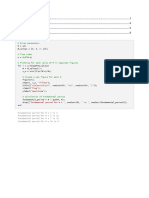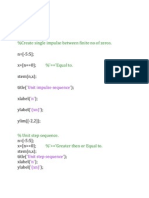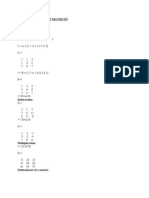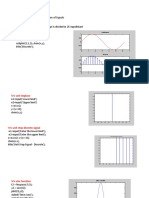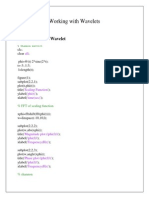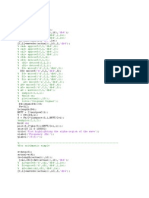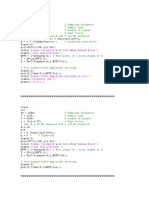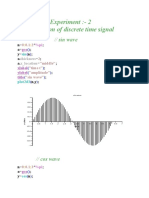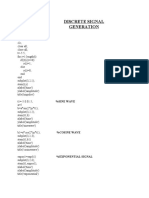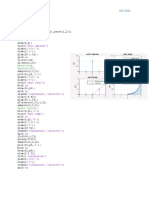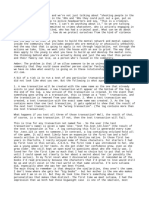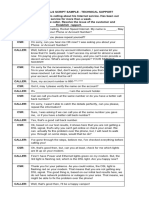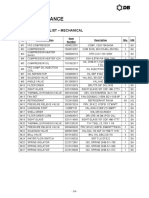clear all;
clc;
close all;
load wav2.mat %Open the wav2.mat data set y3
x=0:0.01:9.99; % Takes x as a geometric sequence between 0 and 9.99 as the time
N=6; % Represents five levels
f=zeros(6,1000); %f represents the low frequency band, divided into five layers. Zeros represents a
matrix of all zeros, with 5 rows and 1000 columns
h=zeros(6,1000); %h represents the high frequency band divided into five layers
[c,l]=wavedec(y3,N,'haar');
% Decompose the signal with one-dimensional N-scale using y3, and return the wavelet
coefficients of each layer, haar represents the Haar wavelet, which is the selected wavelet basis function
% Return value on the left: C is each coefficient after wavelet decomposition, L is the number of
corresponding wavelet coefficients;
for i=1:6 %i takes 1 to 5 respectively to do the following loop operation
f(i,:)=wrcoef('a',c,l,'haar',i); % All elements of the i-th row of matrix f
h(i,:)=wrcoef('d',c,l,'haar',i); %wrcoef is a one-dimensional multi-level decomposition and
reconstruction signal function, using the c and l values obtained just after decomposition to reconstruct
the original signal, that is, the return value on the left;
% 'a' or'd' stands for "low frequency approximation" or "high frequency details", C and L are the
values obtained just after decomposition, and "haar" means consistent with the wavelet basis function
during decomposition, and the last number i is where the part is located series;
end
figure(1) %Create figure 1;;
subplot(3,2,1); % Divide the current figure into a 3×2 grid, and create an axis at the first position.
Number the sub-picture position by line number.
% The first subgraph is the first column of the first row, the second subgraph is the second
column of the first row, and so on.
% If the specified location already has an axes, this command will set the axes as the
current axes。
plot(x,y3,'r'); % In the sub-picture window, draw a function image where x is the abscissa, y3 is the
ordinate, and ‘r’ represents the use of a red line
title('原始信号'); % The sub-picture title is ‘Original Signal’
xlabel('时间 s'); %x axis is marked as ‘time s’
subplot(3,2,3); % Divide the current figure into a 3×2 grid, and create an axis at the third position。
plot(x,f(5,:)); %x is used as the abscissa, and the low frequency band of the reconstructed signal of the
5th layer is used as the ordinate, and the graph is drawn;
xlabel('时间 s'); %x axis is marked as ‘time s’
ylabel('a5'); %y axis is labeled ‘a5’
grid on; % Show grid lines (grid off means hidden grid lines)
subplot(3,2,4); % Divide the current figure into a 3×2 grid, and create an axis at the fourth position.
plot(x,h(5,:)); %x is used as the abscissa, and the high frequency band of the reconstructed signal of
the 5th layer is used as the ordinate, and the graph is drawn;
xlabel('时间 s'); %x axis is marked as ‘time s’
ylabel('d5'); %y axis is labeled ‘d5’
grid on; % Show grid lines
subplot(3,2,5); % Divide the current figure into a 3×2 grid, and create an axis at the fifth position。
plot(x,f(4,:)); %x is the abscissa, the low frequency band of the reconstructed signal of the 5th layer is
the ordinate, and the picture is drawn; (Originally it was f5, I changed it to f4 了)
xlabel('时间 s'); %x axis is marked as ‘time s’
ylabel('a4'); %y axis is marked as ‘a4’
grid on; % Show grid lines
subplot(3,2,6);%将当前图窗划分为 3×2 网格,并在第 6 个位置创建坐标区。
plot(x,h(4,:)); %x 做横坐标,第 4 层的重构信号的高频段做纵坐标,画图;(本来是 h5,我改成 h4 了)
xlabel('时间 s'); %x 轴标记为‘时间 s’
ylabel('d4'); %y 轴标记为‘d4’
grid on; %显示网格线
figure(2) %创建图窗 2;
subplot(3,2,1); %将当前图窗划分为 3×2 网格,并在第 1 个位置创建坐标区。
plot(x,f(3,:)); %x 做横坐标,第 3 层的重构信号的低频段做纵坐标,画图;
xlabel('时间 s'); %x 轴标记为‘时间 s’
ylabel('a3'); %y 轴标记为‘a3’
grid on; %显示网格线
subplot(3,2,2); %将当前图窗划分为 3×2 网格,并在第 2 个位置创建坐标区。
plot(x,h(3,:)); %x 做横坐标,第 3 层的重构信号的高频段做纵坐标,画图;
xlabel('时间 s'); %x 轴标记为‘时间 s’
ALGOIRTHM
clear all;
clc;
close all;
StepData = xlsread('C:\Users\debuf\Desktop\y1.xlsx');
ys=StepData (1,:);
Ls=length(ys);
ys_g= resample(ys, 1000, Ls);
figure(1)
subplot(3,1,1);
plot(ys_g,'r')
title('原始信号');% The sub-picture is titled ‘Original Signal’
xlabel('时间 s'); %x The axis is labeled ‘time s’
N=5; % Represents five levels
f=zeros(5,1000); %f represents the low frequency band, divided into five layers.
Zeros represents the generation of a matrix of all 0s, with 5 rows and 1000
columns
h=zeros(5,1000); %h represents the high frequency band divided into five layers
[c,l]=wavedec(ys_g,N,'db3');
for i=1:5 %i takes 1 to 6 respectively to do the following loop operation
f(i,:)=wrcoef('a',c,l,'db3',i); % All elements in the i-th row of matrix f,'a' or'd'
stand for "low frequency approximation" or "high frequency details"
h(i,:)=wrcoef('d',c,l,'db3',i); %wrcoef is a one-dimensional multi-level
decomposition and reconstruction signal function, using the c and l values just
decomposed to reconstruct the original signal, that is, the return value on the
left;
%'a' or'd' stands for "low frequency approximation" or "high frequency details", C
and L are the values obtained just after decomposition, and "haar" means that
they are consistent with the wavelet basis function during decomposition, and the
last number i is where the part is The number of levels;
end
x=0:0.01:9.99;
subplot(3,2,3); % Divide the current figure into a 3×2 grid, and create an axis at
the third position。
plot(x,f(5,:)); %x is the abscissa, and the low frequency band of the reconstructed
signal of the 5th layer is the ordinate, and the graph is drawn;
xlabel('时间 s'); %x axis is marked as ‘time s’
ylabel('a5'); %y axis is labeled ‘a5’
grid on; % Show grid lines (grid off means hidden grid lines)
subplot(3,2,4); % Divide the current figure into a 3×2 grid, and create an axis at
the fourth position。
plot(x,h(5,:)); %x is the abscissa, and the high frequency band of the
reconstructed signal of the 5th layer is the ordinate, and draw the picture;
xlabel('时间 s'); %x axis is marked as ‘time s’
ylabel('d5'); %y axis is labeled ‘d5’
grid on; % Show grid lines
subplot(3,2,5); % Divide the current figure into a 3×2 grid, and create an axis at
the fifth position.
plot(x,f(4,:)); %x is the abscissa, the low frequency band of the reconstructed
signal of the 5th layer is the ordinate, and the picture is drawn; (it was originally
f5, I changed it to f4)
xlabel('时间 s'); %x axis is marked as ‘time s’
ylabel('a4'); %y axis is labeled ‘a4’
grid on; % Show grid lines
subplot(3,2,6); % Divide the current figure into a 3×2 grid, and create an axis at
the sixth position.
plot(x,h(4,:)); %x is the abscissa, the high frequency band of the reconstructed
signal of the 4th layer is the ordinate, and the picture is drawn; (it was originally
h5, I changed it to h4)
xlabel('时间 s'); %x axis is marked as ‘time s’
ylabel('d4'); %y axis is labeled ‘d4’
grid on;
figure(2) % Create figure 2;
subplot(3,2,1); % Divide the current figure into a 3×2 grid, and create an axis at
the first position。
plot(x,f(3,:)); %x is used as the abscissa, and the low frequency band of the
reconstructed signal of the third layer is used as the ordinate, and the graph is
drawn;
xlabel('时间 s'); %x axis is marked as ‘time s’
ylabel('a3'); %y axis is labeled ‘a3’
grid on; % Show grid lines
subplot(3,2,2); % Divide the current figure into a 3×2 grid, and create an axis at
the second position。
plot(x,h(3,:)); %x is the abscissa, and the high frequency band of the
reconstructed signal of the 3rd layer is the ordinate, and draw the picture;
xlabel('时间 s'); %x axis is marked as ‘time s’
ylabel('d3'); %y axis is labeled ‘d3’
grid on; % Show grid lines
subplot(3,2,3); % Divide the current figure into a 3×2 grid, and create an axis at
the third position。
plot(x,f(2,:)); %x is used as the abscissa, and the low frequency band of the
reconstructed signal of the second layer is used as the ordinate, and the graph is
drawn
;xlabel('时间 s'); %x axis is marked as ‘time s’
ylabel('a2'); %y axis is marked as ‘a2’
grid on; % Show grid lines




